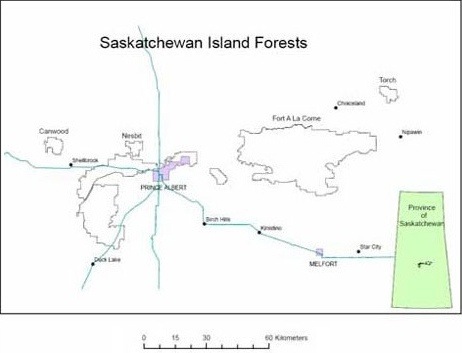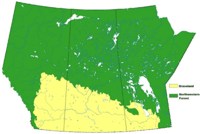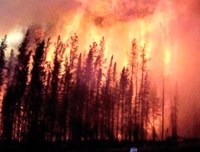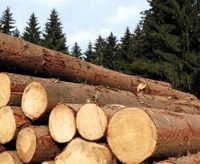Forest Management
Adapting to Shifting Ecosystems
The Provincial Forest in Saskatchewan makes up 54.5% of the total provincial land area. Wetlands dominate almost half of the forest. Moving south out of the northern forest there is a transition to aspen parkland and then to grassland, where potential evapotranspiration exceeds precipitation. Forests are subject to drought, insect attack, mistletoe and fires.
Most timber of commercial value in Saskatchewan is in the southern boreal forest, where the relatively warm climate and deep soils support a diverse and productive mix of pure conifer forests and extensive mixed-wood forests consisting of white spruce, jack pine or black spruce mixed with trembling aspen, balsam poplar or white birch.
Forest health and production, and environmental impacts of forestry activity are all extremely sensitive to weather and climate conditions. In many boreal landscapes, conditions are too wet during the summer, so forest harvesting and hauling are done in the winter when soils are frozen. The impact of climate change on forestry will also have a direct impact on the resource communities associated with forestry activity.
The capacity to adapt is highly variable among producers and forest protection managers but sustainable forest management principles are well understood.
What You Should Know
The Future Climate:
- Saskatchewan's climate is expected to be:
- warmer,
- drier,
- more variable and
- experience more frequent and more intense extreme events (e.g. precipitation, drought).
- Precipitations patterns will change - generally wetter springs and drier summers
- Droughts may increase in intensity and duration
- Climate models suggest that winters will warm more than other seasons and that winter precipitation will increase, with a greater proportion of precipitation falling as rain
The Vulnerability of Saskatchewan's Forests:
- Forests in Saskatchewan are already vulnerable to a range of climate and natural disturbance factors (fire, insects, drought), and may be more vulnerable to climate change than other forest regions in Canada.
- Warmer, drier conditions in the future means the southern margin of the boreal forest will become increasingly vulnerable and may eventually lose forest cover altogether.
- Recent research suggests increased tree mortality resulting from the interaction of insects, drought and fire in the southern margin of the boreal forest in the Prairie Provinces
- Tree productivity may increase in the central and northern parts of the boreal forest owing to increased heat and a longer growing season.
The Anticipated Impacts:
On Species Distribution
- Conditions may be more suitable to different types of trees and require the use of new varieties or new species in regeneration.
- Trees will likely be lost from the southern margin of the boreal forest due to lack of available moisture but will preferentially survive in more northerly locations where rainfall is higher.
- At the landscape scale, local topography and moisture conditions may be sufficient for tree growth in some isolated, southerly locations. This will result in a fragmented mosaic of forest and grassland rather than a wholesale movement of all tree species to the north.
On Productivity and Fire
- Longer growing seasons and higher temperatures could mean improved tree growth, if water and other conditions are not limiting.
- Increased risk of insects and diseases could mean more damage, losses, and management challenges. Mountain Pine Beetle is limited by the occurrence of -40°C temperatures in early winter. With warming, this limiting temperature is likely to occur further to the north and east, allowing the beetle to spread into jack pine in the boreal forest. Any impacts would be most severe in pure jack pine stands.
- More frequent and extreme droughts mean increased risk of stress on trees and higher frequency and intensity of forest fires with a longer fire season. This will likely favour aspen over conifers.
- Forest growth may increase at some sites and decrease at others under future climate conditions, since the effects of CO2 fertilization may be enhanced when other resources are not limiting, or reduced due to limitations in other environmental resources (nutrients, water)
On Timber Harvesting
- Decreased severity and length of winters mean less time for winter operations and risk of thawing damage to trees during winter warm spells.
- Warmer and wetter springs will likely restrict the period of spring hauling, thereby increasing costs and affecting timely delivery to the mill site, with more frequent road closures and impacts to infrastructure (e.g. culverts, bridges, stream crossings).
On the Forest Economy
- While productivity gains in Canada's forestry industry are projected, gains in tropical forestry are expected to be even greater. As a result, foreign demand for the North American forest sector is expected to decrease.
Moving Forward - Adaptation Options:
- Forest management institutions need to be examined for the extent to which they support or hinder the development and implementation of adaptation options. Consideration of new species, assisted migration of existing species and populations, and revised tenure agreements are examples of policy changes that could assist in more effective adaptation.
- Investigate a wide range of adaptation measures, including managing forests to reduce fuel loads and fire loss potential; assisting the migration of commercial tree species; thinning forests to enhance growth and insect/disease resistance; and maintaining connectivity.
- Consider the establishment of non-native species that are better suited to warmer, drier conditions than native species. Some non-native species established in Saskatchewan's forests have demonstrated faster growth rates than native species indicating the potential to increase forest productivity. As with all non-native species, precautions must be taken before widespread planting occurs. Species would have to be assessed (e.g. through planting trials) for risk of invasiveness and threat to native ecosystems. The focus should be on the preservation of forest ecosystems with sustainable species mixes, and not on the establishment of monoculture forests on Crown forest lands.
- Investigate FIRESMART (see footnote 1) techniques for decreasing vulnerability to extreme fire events
- Local autonomy and flexibility in decision-making will become increasingly important in an environment in which conditions are changing rapidly and where the past is no longer a guide to the future.
- Explore opportunities to expand forestry operations further north into the boreal shield as the tree line shifts northward and as forest productivity in these regions increases. Depending on future world markets for wood and paper products, employment and economic opportunities could present themselves to some northern communities that do not presently benefit from forestry.
- Cautiously examine short-term economic opportunities to harvest forested regions that are projected to disappear before they are permanently lost to disturbances such as fire, drought or insect infestation. This kind of approach is being utilized by the British Columbia government as it tries to find ways to maximize the economic value of vast areas of lodgepole pine damaged by the mountain pine beetle. However, impacts of intensive salvage harvesting on ecosystem function and biodiversity can be negative.
Example of Adaptation in Forest Management
Island Forests in Central Saskatchewan
The southernmost provincial forests in central Saskatchewan (Figure 1) are characterized by patches of isolated boreal forest cover dominated by either jack pine or trembling aspen, 60% of which are more than 70 years old.

The Island Forests may already be showing signs of climate change impacts, and are likely to be severely affected in the future from:
- increasing winter temperatures
- increasing aridity
- increasing pathogen and fire hazard
Adaptation Options:
Monitoring Opportunity
- The Island Forests are an excellent example of the "canary in the mine shaft", where the impacts of climate change are likely to occur earlier than in the contiguous boreal forest to the north. This area could form part of a national "early warning" network of intensively monitored sites.
Forest Management Activities
- Immediate and aggressive regeneration of harvested and burned stands to ensure forest cover is maintained.
- Selection of seed from drought-resistant individuals could assist with maintaining future forest cover.
- Experimental planting and monitoring of exotic species (e.g. red pine, ponderosa pine) may help identify species that will grow better under future conditions.
Planning
- Implement an integrated land management approach to support all resource development actors in reducing their environmental footprint in light of the climate change vulnerabilities identified above.
- Given that regeneration failure following fire or harvest is likely on some sites, management planning needs to include the potential for change to grasslands in some locations.
Sources:
- Carr et al (2004): Climate Change Implications in Saskatchewan's Boreal Forest Fringe and Surrounding Agricultural Areas; Geospatial Consulting, Prince Albert, Saskatchewan. 99 p.
- Climate Change Saskatchewan (no date): Forestry in Saskatchewan: Dealing with a Changing Climate. [accessed March 16, 2010]
- Henderson et al (2002): Climate Change Impacts on the Island Forests of the Great Plains and the Implications for Nature Conservation Policy; Prairie Adaptation Research Collaborative, Regina, Saskatchewan, 116 p.
- Sauchyn, D. et al (2009): Saskatchewan's Natural Capital in a Changing Climate: An Assessment of Impacts and Adaptation. 162 pp.
- Thorpe et al (2006): Ecological and Policy Implications of Introducing Exotic Trees for Adaptation to Climate Change in the Western Boreal Forest. Final Report submitted to the Prairie Adaptation Research Collaborative. Saskatchewan Research Council Publication No. 11776-1E06. Saskatchewan Research Council, Saskatoon, SK.
Footnote 1: FIRESMART is a multijurisdictional program that provides information on how to prevent accidental fires and reduce the potential damage or loss of life and property from fire.


